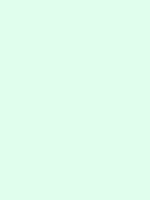#e0feed Color Information
In a RGB color space, hex #e0feed is composed of 87.8% red, 99.6% green and 92.9% blue. Whereas in a CMYK color space, it is composed of 11.8% cyan, 0% magenta, 6.7% yellow and 0.4% black. It has a hue angle of 146 degrees, a saturation of 93.8% and a lightness of 93.7%. #e0feed color hex could be obtained by blending #ffffff with #c1fddb. Closest websafe color is: #ccffff.
-
- R 88
- G 100
- B 93
-
- C 12
- M 0
- Y 7
- K 0
● #e0feed color description : Light grayish cyan - lime green.
#e0feed Color Conversion
The hexadecimal color #e0feed has RGB values of R:224, G:254, B:237 and CMYK values of C:0.12, M:0, Y:0.07, K:0. Its decimal value is 14745325.
| Hex triplet | e0feed | #e0feed |
|---|---|---|
| RGB Decimal | 224, 254, 237 | rgb(224,254,237) |
| RGB Percent | 87.8, 99.6, 92.9 | rgb(87.8%,99.6%,92.9%) |
| CMYK | 12, 0, 7, 0 | |
| HSL | 146°, 93.8, 93.7 | hsl(146,93.8%,93.7%) |
| HSV (or HSB) | 146°, 11.8, 99.6 | |
| Web Safe | ccffff | #ccffff |
| CIE-LAB | 97.164, -12.828, 4.846 |
|---|---|
| XYZ | 81.465, 92.844, 93.745 |
| xyY | 0.304, 0.346, 92.844 |
| CIE-LCH | 97.164, 13.712, 159.305 |
| CIE-LUV | 97.164, -15.414, 9.713 |
| Hunter-Lab | 96.356, -17.708, 9.765 |
| Binary | 11100000, 11111110, 11101101 |
Color Schemes with #e0feed
Alternatives to #e0feed
Below, you can see some colors close to #e0feed. Having a set of related colors can be useful if you need an inspirational alternative to your original color choice.
#e0feed Preview
This text has a font color of #e0feed.
<span style="color:#e0feed;">Text here</span>This paragraph has a background color of #e0feed.
<p style="background-color:#e0feed;">Content here</p>This element has a border color of #e0feed.
<div style="border:1px solid #e0feed;">Content here</div>.text {color:#e0feed;}.background {background-color:#e0feed;}.border {border:1px solid #e0feed;}Shades and Tints of #e0feed
A shade is achieved by adding black to any pure hue, while a tint is created by mixing white to any pure color. In this example, #000703 is the darkest color, while #f3fff8 is the lightest one.
-
#000703
#000703rgb(0,7,3) -
#011a0c
#011a0crgb(1,26,12) -
#012d14
#012d14rgb(1,45,20) -
#02401d
#02401drgb(2,64,29) -
#035325
#035325rgb(3,83,37) -
#03662e
#03662ergb(3,102,46) -
#047937
#047937rgb(4,121,55) -
#058c3f
#058c3frgb(5,140,63) -
#059f48
#059f48rgb(5,159,72) -
#06b250
#06b250rgb(6,178,80) -
#06c559
#06c559rgb(6,197,89) -
#07d862
#07d862rgb(7,216,98) -
#08eb6a
#08eb6argb(8,235,106)
-
#0ff774
#0ff774rgb(15,247,116) -
#22f87f
#22f87frgb(34,248,127) -
#35f88a
#35f88argb(53,248,138) -
#48f995
#48f995rgb(72,249,149) -
#5bfaa0
#5bfaa0rgb(91,250,160) -
#6efaab
#6efaabrgb(110,250,171) -
#81fbb6
#81fbb6rgb(129,251,182) -
#94fcc1
#94fcc1rgb(148,252,193) -
#a7fccc
#a7fcccrgb(167,252,204) -
#bafdd7
#bafdd7rgb(186,253,215) -
#cdfde2
#cdfde2rgb(205,253,226) -
#e0feed
#e0feedrgb(224,254,237) -
#f3fff8
#f3fff8rgb(243,255,248)
Tones of #e0feed
A tone is produced by adding gray to any pure hue. In this case, #efefef is the less saturated color, while #e0feed is the most saturated one.
-
#efefef
#efefefrgb(239,239,239) -
#eef0ef
#eef0efrgb(238,240,239) -
#ecf2ef
#ecf2efrgb(236,242,239) -
#ebf3ee
#ebf3eergb(235,243,238) -
#eaf4ee
#eaf4eergb(234,244,238) -
#e9f5ee
#e9f5eergb(233,245,238) -
#e7f7ee
#e7f7eergb(231,247,238) -
#e6f8ee
#e6f8eergb(230,248,238) -
#e5f9ee
#e5f9eergb(229,249,238) -
#e4faed
#e4faedrgb(228,250,237) -
#e2fced
#e2fcedrgb(226,252,237) -
#e1fded
#e1fdedrgb(225,253,237) -
#e0feed
#e0feedrgb(224,254,237)
Color Blindness Simulator
Below, you can see how #e0feed is perceived by people affected by a color vision deficiency. This can be useful if you need to ensure your color combinations are accessible to color-blind users.
